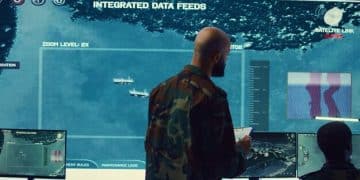US Military’s New Cybersecurity Initiatives Protecting Infrastructure

The US military is actively rolling out advanced cybersecurity initiatives to safeguard its critical infrastructure, involving multi-layered defenses, AI integration, and enhanced collaboration, reinforcing national security against evolving cyber threats.
The landscape of modern warfare extends beyond traditional battlefields, transitioning into the complex and often invisible realm of cyberspace. In this evolving domain, the security of interconnected systems, particularly critical infrastructure, is paramount. This article explores US Military’s New Cybersecurity Initiatives: Protecting Critical Infrastructure, examining the robust strategies and technological advancements deployed to fortify national defenses against increasingly sophisticated cyber threats.
The Evolving Cyber Threat Landscape for Critical Infrastructure
The digital age has brought unprecedented connectivity and efficiency, but with it, a heightened vulnerability to cyber attacks. Critical infrastructure, encompassing essential services like energy grids, transportation networks, communication systems, and financial institutions, represents a prime target for adversaries seeking to disrupt national stability and economic well-being. The US military recognizes that a successful attack on these systems could have devastating, cascading effects far beyond the digital sphere.
The nature of these threats is constantly evolving, driven by state-sponsored actors, sophisticated criminal organizations, and even lone wolves. These entities employ a diverse arsenal of tactics, including ransomware, denial-of-service (DoS) attacks, supply chain compromises, and advanced persistent threats (APTs). The sheer volume and complexity of these attacks demand a dynamic and proactive defense posture from the US military. This isn’t just about protecting military networks; it’s about safeguarding America’s foundational pillars.
Understanding the Adversary’s Motivations
Cyber adversaries are motivated by a spectrum of objectives, ranging from espionage and intellectual property theft to direct sabotage and disruption. State-sponsored groups may seek to gain geopolitical advantage or gather intelligence for future conflict. Cybercriminals are often driven by financial gain, while hacktivists aim to promote political or social agendas. Understanding these motivations is crucial for developing targeted defenses.
Key Vulnerabilities in Critical Infrastructure
Critical infrastructure often relies on legacy systems not originally designed with modern cybersecurity in mind. This creates significant vulnerabilities. The increasing interconnectedness of these systems, often through the Internet of Things (IoT) and operational technology (OT), further expands the attack surface, making them susceptible to remote exploitation.
The challenge is amplified by the sheer scale and decentralization of many critical infrastructure networks. Identifying and patching every potential weakness requires continuous vigilance and considerable resources. The military’s initiatives focus on systemic improvements rather than isolated fixes, aiming to create a more resilient and adaptable defense throughout.
Multi-Layered Defense Strategies: A Citadel Approach
Responding to the multifaceted nature of cyber threats, the US military has adopted a multi-layered defense strategy, often referred to as a “citadel approach.” This involves implementing overlapping security controls at various points within a network and across different domains, ensuring that if one layer is breached, others stand ready to detect and mitigate the intrusion. This complex web of defenses is designed to significantly increase the cost and difficulty for attackers.
This strategy begins with robust perimeter defenses, including advanced firewalls, intrusion detection and prevention systems (IDPS), and secure gateways that filter malicious traffic before it can enter critical networks. Beyond the perimeter, internal segmentation isolates sensitive systems, preventing an attacker who gains initial access from moving freely throughout the network. This segmentation limits the potential damage of a successful breach.
Inside the network, continuous monitoring and analysis are paramount. Security operations centers (SOCs) leverage sophisticated tools and human intelligence to detect anomalous behavior, identify potential threats, and respond swiftly to incidents. Data encryption, both in transit and at rest, ensures the confidentiality and integrity of sensitive information, even if it falls into unauthorized hands. Furthermore, the military prioritizes the development of secure software and hardware, embedding security into the very foundation of its digital infrastructure.
Zero Trust Architecture
* Zero trust assumes no user or device, whether inside or outside the network, can be implicitly trusted.
* Every access request is verified based on context, user identity, and device posture.
* It minimizes the attack surface by enforcing strict access controls and continuous authentication.
Advanced Threat Intelligence Integration
* Sharing intelligence on emerging threats and attacker tactics with government agencies and private sector partners.
* Using AI and machine learning to analyze vast amounts of threat data and predict future attack vectors.
* Proactive identification of vulnerabilities before they can be exploited by adversaries.
The citadel approach emphasizes not just preventing attacks, but also minimizing their impact and enabling rapid recovery. This resilience-focused mindset is a cornerstone of modern military cybersecurity doctrine. Developing this resilience involves regular drills, incident response planning, and a culture of continuous improvement.
Cyber Workforce Development and Training: The Human Element
While technology forms the backbone of cybersecurity, the human element remains undeniably critical. The US military recognizes that a highly skilled and continuously trained cyber workforce is essential for effectively operating and defending its complex digital infrastructure. Recruitment, retention, and ongoing education are top priorities, ensuring a steady pipeline of talent to meet evolving demands. This involves investing in comprehensive training programs, specialized certifications, and realistic simulation exercises to equip personnel with the necessary expertise.
The demand for cybersecurity professionals far outstrips the current supply, making talent acquisition a significant challenge for both the military and the private sector. To address this, the military is implementing innovative recruitment strategies, targeting individuals with diverse backgrounds and skill sets, from ethical hackers to data scientists. They are also developing robust career pathways to encourage long-term commitment and foster expertise within the ranks.
Training programs are designed to be dynamic and adaptable, reflecting the rapid pace of technological change and the emergence of new cyber threats. This includes advanced technical courses on topics such as network forensics, malware analysis, and offensive and defensive cyber operations. Beyond technical skills, emphasis is also placed on critical thinking, problem-solving, and the ability to operate effectively under pressure. These are not merely IT specialists; they are cyber warriors.
Key Pillars of Cyber Workforce Development
* Recruitment and Retention: Implementing competitive compensation and benefits, fostering a culture of innovation, and offering clear career progression paths.
* Specialized Training Programs: Developing bespoke curricula focused on military-specific cyber operations, threat intelligence, and critical infrastructure protection.
* Cyber Ranges and Simulations: Providing realistic training environments where personnel can practice defending against emulated real-world attacks.

The collaboration between military branches, government agencies, and academic institutions is also vital for knowledge sharing and maintaining a competitive edge. This collective expertise allows the military to stay ahead of adversaries and adapt its strategies effectively. The human element, therefore, is not a weak link but a crucial asset, constantly evolving and adapting to the cyber battleground.
AI and Machine Learning Integration: Smart Defense
The sheer volume and velocity of cyber threats make it impossible for human analysts alone to detect and respond to every potential incident. This reality has driven the US military to significantly invest in and integrate artificial intelligence (AI) and machine learning (ML) capabilities into its cybersecurity initiatives. These advanced technologies act as force multipliers, enhancing the speed, accuracy, and scale of defensive operations. AI and ML algorithms can process vast datasets of network traffic, system logs, and threat intelligence in real-time, identifying subtle patterns and anomalies that might elude human detection. This allows for proactive threat hunting and rapid incident response, cutting down the time from detection to mitigation.
AI-powered systems can automate routine tasks, freeing up human analysts to focus on more complex, strategic challenges. This includes automated vulnerability scanning, malware analysis, and even predictive threat intelligence. By learning from past attacks and defensive actions, these systems can continuously improve their effectiveness, becoming more sophisticated and resilient over time. The goal is not to replace human experts, but to augment their capabilities significantly.
One of the critical applications of AI/ML is in behavioral analytics. Traditional signature-based detection methods struggle against novel or polymorphic malware. AI, however, can establish baselines of normal network and user behavior, flagging deviations that indicate a potential compromise. This allows for the detection of zero-day exploits and other advanced threats that might otherwise go unnoticed. The military is exploring how these technologies can be applied across various domains, from protecting individual endpoints to securing vast, interconnected operational technology networks.
Applications of AI in Cybersecurity
* Automated Threat Detection: Rapid identification of malware, phishing attempts, and unauthorized access based on behavioral anomalies.
* Predictive Analytics: Forecasting potential attack vectors and vulnerabilities by analyzing global threat data and historical patterns.
* Automated Incident Response: Initiating immediate mitigation actions, such as isolating compromised systems or blocking malicious IP addresses.
The integration of AI and ML is not without its challenges, including the need for large, high-quality datasets for training, ensuring the explainability of AI decisions, and guarding against adversarial AI techniques designed to fool these systems. However, the military views these challenges as surmountable, given the immense strategic advantages that AI-powered defense offers in the ongoing cyber war. This is a game-changer in the defense against advanced persistent threats.
International Collaboration and Information Sharing: A United Front
Cyber threats transcend national borders, demanding a coordinated and collaborative international response. The US military actively engages in extensive international collaboration and information sharing initiatives to bolster global cybersecurity and protect critical infrastructure. No single nation can effectively combat the entirety of cyber threats in isolation; therefore, building strong alliances and fostering trust among partners is paramount. These collaborations involve sharing threat intelligence, best practices, and lessons learned from cyber incidents, creating a collective defense posture that benefits all participants.
This cooperative approach includes joint cyber exercises, where military cyber units from different nations train together to simulate responses to complex cyber attacks. These exercises improve interoperability, refine communication channels, and build mutual understanding of defensive strategies. Such training enhances the collective ability to deter and respond to sophisticated state-sponsored attacks that might target multiple countries simultaneously. The goal is to establish a robust global network of defenders capable of rapid, coordinated action.
Furthermore, the US military participates in international forums and organizations dedicated to cybersecurity, contributing to the development of global norms, standards, and policies for responsible state behavior in cyberspace. This diplomatic engagement is crucial for promoting stability and discouraging malicious activities online. By working together, nations can build a more resilient global digital ecosystem, making it harder for adversaries to exploit vulnerabilities across jurisdictions. This also includes efforts to combat cybercrime and dismantle international hacking networks.
Key Areas of International Cooperation
* Intelligence Sharing: Exchanging real-time threat data with allies to preempt attacks and understand adversary tactics.
* Joint Cyber Drills: Conducting simulated cyber warfare scenarios to enhance readiness and interoperability among allied forces.
* Capacity Building: Assisting partner nations in developing their own cybersecurity capabilities through training and technology transfer.
The strategy recognizes that critical infrastructure globally is interconnected, and a compromise in one nation can have ripple effects worldwide. Therefore, strengthening the cyber defenses of allies and partners is not only an act of solidarity but also a direct contribution to US national security. This unity discourages aggression and enhances the collective ability to prevent widespread damage from cyber incidents.
Future Outlook and Continued Adaptation: Staying Ahead
The nature of cyberspace ensures that the battle for digital supremacy will be a continuous one, necessitating constant innovation and adaptation. The US military’s new cybersecurity initiatives are not static; they represent an ongoing commitment to evolving alongside the threat landscape. The future outlook involves pushing the boundaries of defensive capabilities, anticipating emerging technologies and their associated risks, and fostering a culture of perpetual learning and improvement. Staying ahead requires a proactive stance, not merely a reactive one.
One key area of focus involves leveraging quantum computing and post-quantum cryptography to secure data against future decryption threats. As quantum computers become more powerful, traditional encryption methods may become vulnerable, making it imperative to develop and deploy quantum-resistant algorithms. The military is also exploring the use of advanced simulation and digital twin technologies to test the resilience of critical infrastructure systems against various attack scenarios without disrupting live operations. This allows for rigorous vulnerability assessments and the development of robust countermeasures.
The convergence of cyberspace with other domains, such as space and artificial intelligence, also presents new challenges and opportunities. Protecting satellite networks, crucial for military communications and navigation, from cyber attacks is a growing priority. Similarly, developing secure AI systems and defending against AI-powered cyber attacks will become increasingly critical. The military is investing heavily in research and development to address these complex, interconnected challenges, ensuring technological superiority in the cyber domain.
Emerging Areas of Focus
* Quantum-Resistant Cryptography: Researching and developing encryption methods impervious to quantum computer attacks.
* Space Systems Cybersecurity: Protecting satellite networks and space-based assets from disruption and exploitation.
* Operational Technology (OT) Security: Enhancing defenses for industrial control systems and other critical infrastructure technologies distinct from traditional IT.
The emphasis on public-private partnerships will also intensify. Collaboration with leading technology companies, startups, and academic institutions is vital for rapid innovation and the transfer of cutting-edge research into practical defensive applications. By fostering an ecosystem of collaboration, the US military aims to maintain its edge in the ever-evolving cyber arms race, safeguarding national security and protecting critical infrastructure for decades to come.

Regulatory Frameworks and Compliance: A Foundation of Trust
Beyond technological and human resource initiatives, the success of the US military’s cybersecurity efforts hinges significantly on robust regulatory frameworks and strict compliance. These frameworks provide the operational guidelines, standards, and mandates necessary to ensure a consistent and high level of security across all critical infrastructure sectors. Compliance isn’t merely a bureaucratic exercise; it’s a fundamental pillar of national cybersecurity that builds trust and accountability. These regulations often align with national security directives and international agreements.
The military, in collaboration with Homeland Security and other agencies, plays a crucial role in shaping these regulatory standards, particularly concerning defense industrial base entities and other key infrastructure directly supporting national security. These regulations often include requirements for regular security audits, vulnerability assessments, incident reporting, and the implementation of specific security controls. Adherence to these standards helps to minimize systemic risks and ensures a unified approach to cybersecurity across various organizations involved in critical infrastructure operations. This top-down approach ensures basic levels of security are met.
Compliance also extends to supply chain security. As global supply chains become increasingly intertwined and complex, the risk of malicious hardware or software being introduced into critical systems grows. Regulatory frameworks address this by mandating rigorous vetting processes for vendors and suppliers, ensuring that components and services integrated into critical infrastructure meet stringent security requirements. This proactive measure aims to prevent hidden backdoors or vulnerabilities from compromising vital systems before they are even deployed. Ensuring the integrity of the supply chain is a massive, ongoing task.
Key Aspects of Regulatory Compliance
* Mandatory Security Standards: Enforcing a baseline of security controls, such as multi-factor authentication, network segmentation, and regular patching.
* Incident Reporting Protocols: Establishing clear procedures for reporting cyber incidents to relevant authorities to enable rapid, coordinated responses and intelligence sharing.
* Supply Chain Risk Management: Requiring due diligence and security assessments for all third-party vendors and components used in critical systems.
The continuous evolution of cyber threats necessitates that regulatory frameworks are also dynamic, regularly updated to address new attack vectors and technological advancements. This adaptive regulatory environment provides a solid foundation for the US military’s ongoing cybersecurity initiatives, ensuring that protective measures keep pace with the ever-changing digital landscape and reinforcing the nation’s overall resilience against cyber attacks.
| Key Aspect | Brief Description |
|---|---|
| 🛡️ Multi-Layered Defense | Employing overlapping security controls like Zero Trust to protect infrastructure from various attack vectors. |
| 👩💻 Cyber Workforce Development | Training and recruiting skilled personnel to manage and defend complex digital systems. |
| 🤖 AI & Machine Learning | Integrating AI for automated threat detection, predictive analytics, and faster incident response. |
| 🌍 International Collaboration | Sharing threat intelligence and conducting joint exercises with allies to build collective defense. |
Frequently Asked Questions About US Military Cybersecurity
Critical infrastructure refers to vital systems and assets essential for the functioning of a society and economy. In military cybersecurity, this includes not only direct defense networks but also national power grids, communication systems, water supplies, transportation, and financial institutions, as their disruption could severely impact military operations and national security.
The military uses various strategies to recruit cybersecurity talent, including specialized enlistment programs, attractive compensation packages, academic partnerships, and cyber competitions. They seek individuals with diverse skill sets, from network defense to offensive cyber operations, ensuring a robust and adaptable workforce capable of meeting evolving threats.
Zero Trust is a security model based on the principle that no user or device, whether inside or outside an organization’s network, should be implicitly trusted. It’s crucial because it mandates strict identity verification and continuous authorization for every access request, significantly reducing the attack surface and limiting potential breaches.
AI assists by automating threat detection, analyzing vast data sets for anomalies, and predicting potential attack vectors faster than humans can. It enhances efficiency in incident response by identifying and isolating threats rapidly, freeing human analysts to focus on complex strategic challenges and proactive threat hunting.
International collaboration is vital because cyber threats originate globally and often transcend national borders. Sharing threat intelligence, conducting joint exercises, and establishing common standards with allied nations enhances collective defense capabilities, strengthens global resilience, and creates a united front against state-sponsored and criminal cyber adversaries.
Conclusion
The protection of critical infrastructure stands as a paramount national security objective for the United States. The US military’s proactive and multi-faceted cybersecurity initiatives, encompassing advanced technological integrations, dedicated workforce development, and robust international partnerships, underscore a deep understanding of the evolving cyber threat landscape. These efforts are not merely incremental upgrades but represent a strategic pivot towards a dynamic, resilient, and adaptive defense posture. As cyber warfare continues to reshape geopolitical dynamics, the military’s ongoing commitment to innovation and collaboration in cybersecurity ensures the unwavering security and stability of the nation’s essential services against an increasingly complex array of digital adversaries. The vigilance and foresight embedded in these initiatives are crucial for safeguarding the future.





